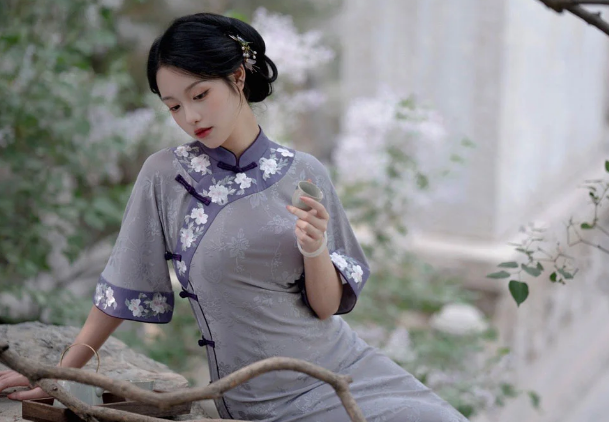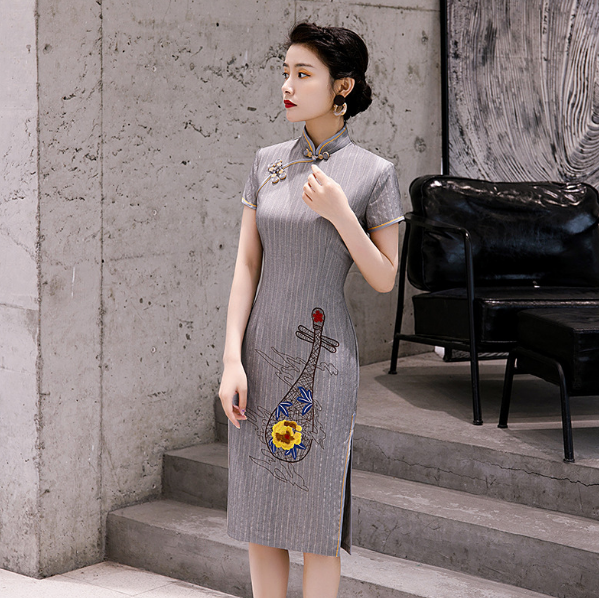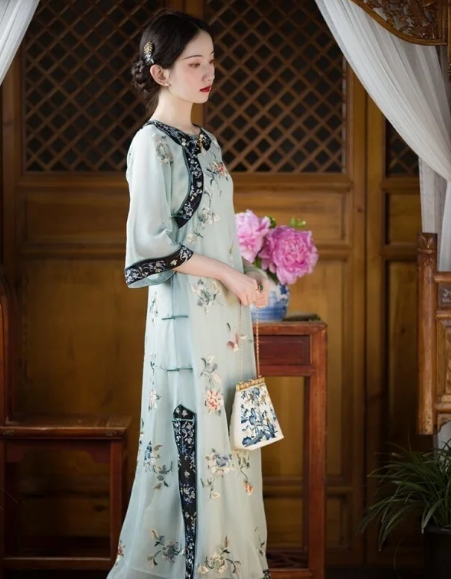Historical Origins of the Cheongsam
The Qing Dynasty Influence
The cheongsam, or “qipao” as it is known in Mandarin, traces its roots back to the Qing Dynasty (1644–1912). This period saw the Manchu rulers impose their own dress codes across China. The original Manchu robe, or “changpao,” was loose and straight, significantly differing from the form-fitting style seen today. It primarily served to signify ethnicity and social status, often showcasing elaborate designs to indicate the wearer’s rank.
During the Qing Dynasty, the cheongsam was not just a fashion statement but a symbol of Chinese cultural identity. As Manchu influence spread, the attire subtly started integrating with Han Chinese clothing styles, leading to a unique fusion. This development represented not just a fashion evolution but also a cultural blending under the Manchu rule.

Evolution from Ancient Chinese Attire
The transformation of the cheongsam over time mirrors the shifts in Chinese fashion and society. Originally, it was a long robe with wide sleeves, worn by both men and women. With the fall of the Qing Dynasty and the onset of the Republican era in the early 20th century, the cheongsam underwent significant changes. Influenced by Western fashion and the desire for modernity, the traditional loose-fitting robe evolved into a more tailored dress. This modern version, especially popular among women in cosmopolitan cities like Shanghai, featured a high neck, snug waist, and a silhouette that highlighted the contours of the body.
During this period, the cheongsam became shorter, with sleeve lengths varying according to the fashion trends and seasons. Materials like silk and brocade, often featuring intricate embroideries, were common, reflecting the high craftsmanship and quality associated with traditional Chinese clothing. The versatility and elegance of the cheongsam made it a staple in the wardrobes of fashionable women across different social strata, marking its transition from a traditional ethnic costume to a symbol of modern Chinese femininity.
The evolution of the cheongsam is a testament to its enduring appeal and adaptability, embodying both the rich heritage and the dynamic nature of Chinese fashion. For more detailed information, the Wikipedia page on Cheongsam offers an extensive overview of its historical development and cultural significance.
Cultural Significance of the Cheongsam
Symbolism in Chinese Culture
The cheongsam, beyond its aesthetic appeal, holds profound symbolic meanings in Chinese culture. It embodies the Chinese ideals of femininity and grace. The high collars signify modesty, while the slits along the sides represent a subtle allure, balancing sensuality with sophistication. The form-fitting nature of the cheongsam outlines the woman’s figure, reflecting the societal shift towards a more open celebration of femininity.
Colors and patterns on a cheongsam also carry deep symbolism. For example, red, often used in cheongsams, symbolizes good fortune and joy in Chinese culture, making it a popular choice for festivals and weddings. The use of dragons and phoenixes in embroidery denotes power, nobility, and luck. Each design element, from the choice of fabric to the style of buttons, tells a part of the rich tapestry of Chinese history and societal values.
Cheongsam in Modern Fashion and Media
The cheongsam has made its mark in modern fashion and media, representing both historical elegance and contemporary chic. Designers around the world have drawn inspiration from its silhouette, creating outfits that blend traditional motifs with modern cuts and materials. In movies and TV shows, the cheongsam often appears in scenes set in historical contexts, or as a symbol of Chinese identity and heritage. The costume design in films like “In the Mood for Love” showcases the cheongsam’s role in cinematic storytelling, adding layers of narrative depth and cultural context.
The versatility of the cheongsam ensures its place not just as a garment but as a cultural icon, evolving with the times while maintaining its distinct identity. From high-fashion runways to the streets of modern cities, the cheongsam continues to be a testament to the endurance and adaptability of traditional styles in the face of modernity.
Design Evolution of the Cheongsam
Traditional vs. Modern Styles
The cheongsam has experienced significant transformations from its traditional form to the modern styles we see today. Traditionally, cheongsams were ankle-length, with a loose fit, long sleeves, and a high neckline. They prioritized modesty and covered most of the body. Silk, embroidered with intricate designs, was the primary material, reflecting high social status and elegance.
Modern styles, however, embrace more form-fitting designs, with variations in length, sleeve style, and neckline. The use of different fabrics like cotton, polyester, and blends alongside silk has made the cheongsam more accessible and versatile. Contemporary designers often experiment with bold colors, contrasting trims, and varied sleeve styles to cater to modern fashion sensibilities while still maintaining the essence of the traditional attire. These changes mirror evolving societal attitudes towards women’s fashion and individuality.
Regional Variations and Influences
Regional variations in the cheongsam’s design reflect the diverse cultural landscapes of China. In Shanghai, the cheongsam took on a more cosmopolitan and trendy style, with shorter lengths and a tighter fit, reflecting the city’s status as a fashion hub. In contrast, cheongsams from regions like Beijing remained more conservative, sticking closer to traditional styles.
Influence from other cultures has also played a significant role in shaping the cheongsam. For example, the integration of Western tailoring techniques in the 20th century led to a more figure-hugging silhouette, distinctly different from the original loose-fitting robes. Hong Kong’s fashion scene, a blend of East and West, has been pivotal in introducing innovative cheongsam styles that feature a mix of traditional Chinese elements with modern Western trends. This interplay of regional and international influences highlights the dynamic nature of the cheongsam as a fashion icon, constantly evolving while maintaining its cultural roots. For a deeper understanding, one can explore Fashion Design which provides insights into how cultural and regional factors influence garment design.
Fabric and Craftsmanship
Traditional Materials and Techniques
In the realm of traditional cheongsams, silk reigns supreme. Silk, known for its texture, sheen, and strength, has historically been a symbol of luxury and status in Chinese culture. Craftsmen often embellished these silk garments with intricate embroideries, featuring motifs like dragons, phoenixes, flowers, and birds, each bearing its own symbolic meaning. The embroidery technique was not merely decorative; it showcased the wearer’s social status and cultural sophistication.
Apart from silk, other materials like satin and brocade were also popular. The craftsmanship involved in making a traditional cheongsam was extensive. Tailors paid meticulous attention to detail, ensuring that each garment fit the wearer perfectly. The buttons, often handmade and covered in fabric, provided both functionality and elegance, showcasing the tailor’s skill and the wearer’s taste.

Innovations in Contemporary Cheongsam Making
Contemporary cheongsam making has embraced innovation while respecting traditional practices. Designers experiment with new materials like lace, chiffon, and velvet, expanding the garment’s appeal and wearability. Technological advancements in textile production and garment construction have also influenced contemporary cheongsam designs. These include the use of digital printing techniques for intricate patterns, which were once only possible through hand embroidery.
Moreover, modern tailoring techniques have allowed for improved fits that cater to a diverse range of body types and preferences, moving away from the one-size-fits-all approach of the past. Contemporary designers often blend Western fashion elements with traditional motifs, creating garments that are both culturally rich and modern. This evolution in materials and techniques demonstrates the cheongsam’s unique position as a garment that respects its historical roots while evolving to meet modern fashion sensibilities. For more insights on the materials used in traditional attire, the Wikipedia page on Textile Fabrics provides comprehensive information.
The Cheongsam in Social and Political Contexts
The Cheongsam during the Republican Era
During the Republican era in China, the cheongsam emerged as a symbol of modernity and national identity. This period saw the transition from traditional loose-fitting Han attire to the more form-fitting cheongsam. It reflected the broader social changes as China moved towards modernization. Women, previously confined to domestic spheres, began adopting the cheongsam as a statement of their newfound social and political roles. The garment thus became associated with the progressive ideals of the era, challenging traditional gender norms and signifying a shift in the cultural landscape of China.
Influential figures, such as Soong Ching-ling and other prominent women in politics and literature, popularized the cheongsam. Their public appearances in these outfits reinforced the cheongsam’s status as a symbol of both elegance and the empowerment of Chinese women. This era’s fashion trends significantly influenced how the cheongsam was perceived, transitioning from a simple dress to a symbol of a nation’s aspiration and identity.
Cheongsam as a Cultural Ambassador
The cheongsam plays a vital role as a cultural ambassador in international contexts. In diplomatic events, international film festivals, and cultural expositions, the cheongsam frequently appears as a representation of Chinese culture and heritage. The garment’s elegance, combined with its rich cultural connotations, makes it an effective tool for cultural diplomacy and international engagement.
Designers and celebrities often choose the cheongsam for global red carpet events, showcasing Chinese aesthetics on the world stage. Such appearances spark international interest in Chinese fashion and culture, bridging gaps between China and the global community. The cheongsam’s journey from a traditional dress to an icon of global fashion highlights its versatility and the deep cultural resonance it holds, making it more than just an item of clothing but a statement of cultural pride and identity. For more information on the impact of traditional dresses in cultural diplomacy, one can refer to the Wikipedia page on Cultural Diplomacy.

Contemporary Revival and Global Influence
The Cheongsam in International Fashion
The cheongsam has made a distinctive mark in international fashion. Renowned designers globally have drawn inspiration from its silhouette, patterns, and history, incorporating them into modern fashion collections. This cross-cultural fusion highlights the versatility and timelessness of the cheongsam design. In major fashion capitals like Paris, New York, and Milan, runway shows often feature cheongsam-inspired outfits, reimagined with contemporary twists. This blending of East and West showcases the cheongsam’s ability to transcend cultural and geographical boundaries.
Moreover, the cheongsam regularly appears in international cinema and pop culture, further amplifying its global appeal. Films like “In the Mood for Love” and characters like Disney’s Mulan have played pivotal roles in introducing the cheongsam to international audiences. This global exposure not only popularizes the cheongsam but also ignites discussions around traditional attire’s relevance in contemporary fashion.
Preservation and Adaptation in the 21st Century
In the 21st century, efforts to preserve the cheongsam’s heritage while adapting it to modern times have been significant. Designers and cultural institutions are working to maintain the cheongsam’s traditional craftsmanship, while exploring new designs, fabrics, and styles to keep it relevant for contemporary wearers. Museums and fashion exhibitions play a crucial role in this, showcasing historical and modern interpretations of the cheongsam, educating the public about its evolution and cultural significance.
Digital platforms and social media also contribute to the cheongsam’s revival. Online communities share styling tips, patterns, and sources to purchase or tailor cheongsams, making them more accessible to a global audience. Through these efforts, the cheongsam remains a living garment, evolving with the times while honoring its historical roots. Its journey from a traditional Chinese dress to an iconic element of global fashion is a testament to its enduring appeal and adaptability. For further reading on the evolution of traditional costumes in modern times, the Wikipedia page on Fashion History offers valuable insights.